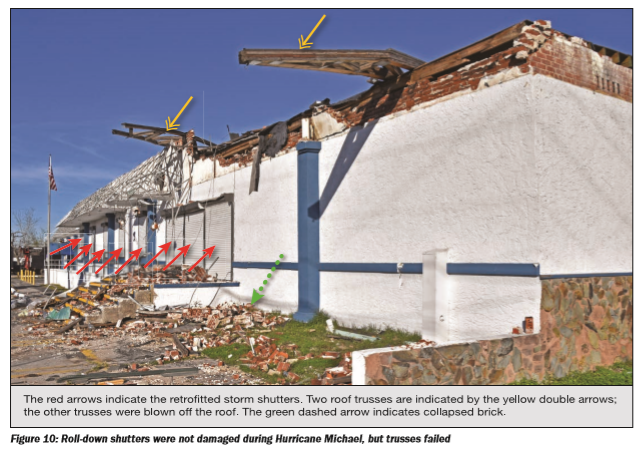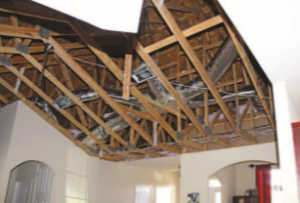Not only was the Florida Building Code not fully effective in buildings damaged by Hurricane Michael, but neither were mitigation efforts designed to fortify our homes and businesses, according to a new FEMA report.
A team of building experts conducted an assessment of 350 structures affected by Michael’s Category 5 winds that reached upwards of 160 mph. They paint a dismal result. Buildings with wind retrofits, such as stronger windows or doors, suffered significant damage, even when those windows and doors held up.
The FEMA report notes people were injured as a result. Expensive mitigation upgrades were for nothing. And entire buildings, including multi-million dollar local government facilities, now have to be rebuilt from scratch.
What happened? Isn’t mitigation supposed to be a smart investment? Host Lisa Miller, a former deputy insurance commissioner, asks her guests, including a former state legislator who had a hand in creating the Florida Building Code and the Panhandle’s wind standards, and two noted structural engineers.

Charlie Clary, Founding Principal, DAG Architects

Dr. Arn Womble, Research Engineer, Insurance Institute for Business & Home Safety

Dr. Karthik Ramanathan, Assistant Vice President & Principal Engineer, AIR Worldwide
Show Notes
This podcast is a follow-up in part, to the August 31, 2019 podcast Is Florida’s Building Code Protecting All of Us? A University of Florida engineering school report found that the Florida Building Code wasn’t tough enough to withstand Michael’s Category 5 winds. Not even in some newer structures, although they did fare better than those built before the 2002 code was enacted. But almost two-thirds of those buildings built after the code had some roof cover loss, according to the report.
Although there is a single state building code, it has different wind standards depending on where you live. The eastern Panhandle, where Hurricane Michael struck, has some of the weakest wind standards in the state, at 130 mph on the coast and 120 mph slightly inland. Former state Senator Charlie Clary was involved in the creation of those wind standards in 2002.
“We tried to come up with some ways of helping, as we made the codes tougher and more uniform throughout the state, but still be somewhat affordable as they constructed these homes, because we were in a very intense growth mode at that time. There had never been a Category 4 or greater hurricane to impact NW Florida at that time,” said Clary, who is founding principal with DAG Architects in Destin, Florida. “We have to just learn lessons from Michael and make the changes necessary.”
In Bay County, ground-zero for Michael, officials estimate nearly 75% of its 68,000 households were impacted.

House with typical envelope damage (roof covering, siding, soffit, and fascia cover) observed on newer buildings after Hurricane Michael in the Panama City area, from FEMA’s Best Practices for Minimizing Wind and Water Infiltration Damage
The UF report noted roof and siding loss was common in both pre-code and post-code construction. Dr. Arn Womble, Research Engineer with the Insurance Institute for Business & Home Safety, said roofing products themselves need improvement and that aging effects seem to play a big role in how the roofs perform.
“We are frustrated as well as I think everybody in the industry in that the standard test for shingles – and we run them in our lab and they pass a certain test and then when they get subjected to reality out there in the field, they don’t perform like the laboratory test indicated that they might, so we’re realizing there’s a big disconnect there,” said Dr. Womble, who led a field survey team after Michael struck. He added that siding products haven’t gotten as much attention as roofing, but need to going forward.
The conversation moved to the newest set of post-Michael reports from FEMA. Its recovery advisory Successfully Retrofitting Buildings for Wind Resistance, resulted from FEMA’s Mitigation Assessment Team survey of Hurricane Michael damage. It found that buildings and homes with wind retrofits suffered significant damage—even in cases when the retrofit itself performed well—because other building vulnerabilities were not addressed when the retrofit was installed. So “the whole retrofit project may be ineffective.”
“It is true that when you mitigate to try to gain more resilience, your building is only as strong as its remaining weakest link,” said Dr. Karthik Ramanathan, Assistant Vice President & Principal Engineer for AIR Worldwide, a global catastrophe modeling firm. He, too, has found disconnects between what mitigation can achieve versus what’s actually happening in the field. As an example, his field work has noted “striking dissimilarity” in metal roofs in areas ravaged by Hurricanes Michael and Irma.
“Most agree if built and installed properly, metal roofs are a great mitigation investment against wind damage. But time and again, you saw metal roofs installed on pre-existing shingle roofs. When you’re not attaching a metal roof to a substrate that it ought to be attached to, you cannot expect a metal roof to perform in the way it is supposed to,” said Dr. Ramanathan. He added that there seems to be a lack of knowledge and a need for education in proper installation.
 The FEMA assessment also found that “even modest damage to the building envelope or rooftop equipment was observed to lead to costly water damage, which can take months to repair and cause disruption of building operations.” A companion assessment, Best Practices for Minimizing Wind and Water Infiltration Damage has some recommendations on building materials to use to provide extra layers of protection.
The FEMA assessment also found that “even modest damage to the building envelope or rooftop equipment was observed to lead to costly water damage, which can take months to repair and cause disruption of building operations.” A companion assessment, Best Practices for Minimizing Wind and Water Infiltration Damage has some recommendations on building materials to use to provide extra layers of protection.
Based on the University of Florida report, the Florida Building Commission has taken several steps with the support of the homebuilders to strengthen the next 7th Edition of the Florida Building Code to be published in December 2020. It includes adoption of ASCE 7-16, the newest Minimum Design Loads and Associated Criteria. While there’s no reported plans to change the various wind standards around Florida, the method for determining the design pressures on roofs for buildings less than 60 feet in height has changed. There are expected to be requirements for secondary roof underlayment to prevent water intrusion in the event the roof covering is blown off. This is for new construction as this standard has been around over 10 years for reroofing work.
New sections are also being added to the code detailing requirements for the attachment of vinyl, fiber-cement, and hardboard. Wood structural panels and soffit panels are also being added to the code. All these moves were applauded by the podcast’s guests.
“I’d like to see the building code and material science move down the building envelope now from the roof,” said Dr. Ramanathan, who focuses on the structural impacts of storms in his work. “I think the research now needs to focus more heavily on how you build soffits that can withstand the impact of wind-driven rain so that you can keep the home’s envelope watertight. How do you look at the performance of wall siding, be it vinyl or brick, how can you make these better?” He noted that water damage is more expensive to repair than wind damage.

House with significant interior damage from water intrusion, Courtesy FEMA
All three guests agreed that code enforcement is crucial when building resilient homes and businesses. In a recent guest column in the Insurance Journal, two Munich Re senior executives cite “the need to enhance and consistently enforce building codes” as one of the two big challenges facing reinsurers with Florida interests.
“I think you’re naturally going to have different levels of enforcement just because of the different sorts of budgets throughout the state and the ability to cover what’s necessary,” said Dr. Womble. Given the code is key to protecting consumers, having uniform code enforcement is important, he added.
With Hurricane Michael recovery still ongoing in the Panhandle, “I think we’re definitely on the right path to building under a tougher code,” said Clary. “Enforcement is vital and it’s important to have the architect and engineers that work for the client involved to make sure the structures are built according to plans and specifications.”
Dr. Ramanathan said he sees individual building departments within Florida have gaps in how they adopt and enforce certain practices, including verifying building plans and conducting on-site inspections. “I think the Panhandle and other parts of Florida need to move to the high-velocity zone (170 mph wind standards), which is essentially Miami-Dade and Broward, not just in terms of building standards but also enforcement standards,” said Dr. Ramanathan. “Michael did pretty much just what Hurricane Andrew did, so the time is never more opportune than what it is now to reflect that learning, in terms of building code enforcement in the Panhandle.”
FEMA will use its two assessments to develop formal conclusions and recommendations to improve resilience of buildings and their utility systems in Florida. A formal report is expected by December 2019.
Host Lisa Miller, a former deputy insurance commissioner, noted “there is ongoing concern that even for those with insurance checks, some Panhandle residents may not be able to afford to rebuild their homes. Is it time for these tougher standards, materials, and practices we’ve discussed today to be enacted across the Florida Panhandle – and across Florida for that matter?”
Links and Resources Mentioned in This Episode
Insurance Institute on Business & Home Safety (IBHS)
www.DisasterSafety.org (IBHS guidance for home and business owners)
Successfully Retrofitting Buildings for Wind Resistance (FEMA Recovery Advisory 1, June 2019)
Best Practices for Minimizing Wind and Water Infiltration Damage (FEMA Recovery Advisory 2, June 2019)
Is Florida’s Building Code Protecting All of Us? (The Florida Insurance Roundup podcast of 8/31/19)
Reports referenced from our previous podcast “Is Florida’s Building Code Protecting All of Us?”:
- Investigation of buildings damaged by Hurricane Michael (The University of Florida Engineering School of Sustainable Infrastructure and Environment, prepared for the Florida Building Commission, June 10, 2019)
- Hurricane Michael: Field Assessment Team Early Access Reconnaissance Report (from Structural Extreme Event Reconnaissance Network, October 25, 2018)
Florida Building Commission Wind Maps
Pitfalls in Mitigating Risk (LMA Newsletter of 8-26-19)
Cities Where Hurricanes Would Cause the Most Damage (24/7 Wall Street, July 31, 2019)
** The Listener Call-In Line for your recorded questions and comments to air in future episodes is 850-388-8002 or you may send email to [email protected] **


